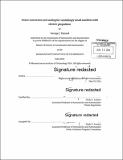Power conversion and scaling for vanishingly small satellites with electric propulsion
Author(s)
Hansel, George J
DownloadFull printable version (5.460Mb)
Other Contributors
Massachusetts Institute of Technology. Department of Aeronautics and Astronautics.
Advisor
Paulo C. Lozano.
Terms of use
Metadata
Show full item recordAbstract
The development of ion electrospray propulsion systems (iEPS) as integrated microelectromechanical systems (i.e. MEMS) effectively miniaturizes propulsion for nanosatellites. Current iEPS thrusters consist of arrays of ion emitters, with a thruster for CubeSat application consisting of hundreds of emitters on a 1 cm² package. As a consequence, the lower bound on the size of satellites incorporating ion-emitter thrusters is not generated by the size of the thrusters themselves but the power supply they require: approximately 1700 volts at hundreds of nanoamps per emitter; a region in parametric space that is poorly explored in terrestrial power converters. We discuss the design and construction of a high-boost-ratio hybrid switched-magnetic/switched-capacitor power supply capable of powering small emitter arrays or single-emitter electrospray propulsion systems. In particular, we discuss the effects of and component requirements necessary for scaling the converter to the size and weight required for a board-level-integrated femtosatellite incorporating several single-emitter thrusters for propulsion and attitude control. This comprises scaling effects for physical and component parameters within a converter topology (such as operating frequency, parasitic effects, and component mass), but also motivates the choice of converter topology, as some are sensitive and others robust to miniaturization.
Description
Thesis: S.M., Massachusetts Institute of Technology, Department of Aeronautics and Astronautics, 2014. Cataloged from PDF version of thesis. Includes bibliographical references (pages 51-53).
Date issued
2014Department
Massachusetts Institute of Technology. Department of Aeronautics and AstronauticsPublisher
Massachusetts Institute of Technology
Keywords
Aeronautics and Astronautics.